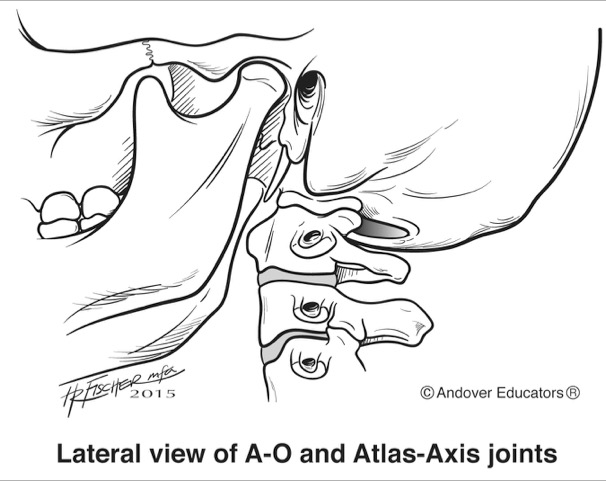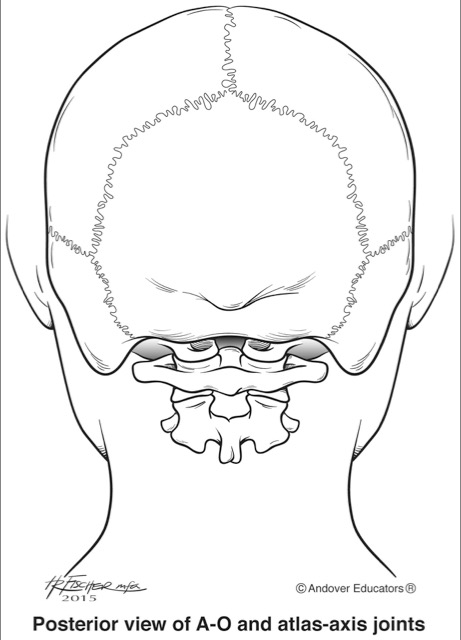After a busy day of teaching or a long practice session, you might notice a pain between the base of your neck and your right shoulder blade. Symptoms can range from general soreness to a stabbing pain, and it can occur on both sides but is more common on the left. The entire back of your neck, up to the base of your skull, could be affected. Does this ever happen to you? If so, you’re not alone. Many flutists have neck pain at some point in their careers, and fortunately there are some movement changes that you can make to help solve this problem.
Get your head on straight
Have you ever considered how and where your head is attached to the rest of your spine? If you haven’t, and your neck hurts, then you should! Wiggle your head around and see where you think the top of your neck meets the bottom of your head.
The joint between the head and the spine is called the Atlanto-occipital (AO) joint because it joins the base of the skull (the occiput) and the top vertebrae (the atlas) and is the most important place of balance in your body (See Image No. 1 below). There are two projections on the base of the occiput that rest in indentations in the atlas and the movement that results is a rocking movement, like nodding back and forth. Think of a Bobble head doll! Turning your head does not happen from this joint, as rotation happens in other areas of the cervical spine. Clearly mapping the location, size and function the AO joint is important. (See Musicians as Movers – Part One from October 25, 2017 for more information about body maps.)

How to Find Your AO Joint
Here are three ways that you can begin to access your map of your AO joint:
#1: Gently rest your index fingers in your ear holes. Imagine that your fingers grow longer and meet in the middle of your head and you will be pointing towards your AO joint.
#2: Take the fingers of one hand and palpate, which means to explore by touch, the back of your neck. Walk your fingers up over soft muscle tissue until you get to a hard bony ridge, which is the base of your skull, and keep your hand there. With your other hand, place your thumb gently under your top teeth. Now rock your head back and forth like a teeter-totter… notice that it’s moving from the center, right between your ears!
#3: Take your tongue and run it along your upper molars. The AO joint is roughly on the same plane.
Most people have their AO joint mapped too low and too far back, when in reality the AO joint is much higher up and much more central. Think up high, in between your ears! (See Image #2 below).

SO WHAT?
The average human heads weighs between 8 and 12 pounds. Think of the weight of a bowling ball or a 10 pound kettlebell. Heads are heavy, and if we’re using the wrong things to hold our heads up, then we’re setting ourselves up for discomfort, pain and dysfunction. We should be taking advantage of the weight-bearing and weight-delivering capabilities of our spines, which are designed to beautifully support the head when the head is balanced at the AO joint. Unfortunately, many people carry their head way out in front, which compromises this support system. It’s easy to see why neck muscles might complain if they are being recruited to hold up your head. Massage therapists work on forward head posture all the time because most people have some sort of issue going here, because the majority of the work we do all day long (like computer work and driving) involves hands and arms in front.
When looking at the musculature of the neck, there are layers of neck muscles, attaching from the base of the skull to various places on collarbones, shoulder blades, sternum and ribs. These are supposed to be head turners, not head holder uppers!
Here is an image showing neck muscles from the side. https://en.wikipedia.org/wiki/Trapezius_muscle#/media/File:Trapezius_Gray409.PNG
The muscle that is often the first to complain when our heads are reaching forward is the trapezius muscle (see picture below.) It connects the base of the skull, collarbone, spine of the shoulder blade and spinal processes of many vertebrae down to T12 in the back.
https://en.wikipedia.org/wiki/Trapezius_muscle#/media/File:Trapezius_Gray409.PNG
How to balance your head
First, you need to know what it looks and feels like when your head is not balanced well.
The most common pattern that I see when working with students is actually two problems—the chin goes up and the back of the skull goes down, AND the entire head is too far forward. In the photos below, the first one shows good balance at the AO joint and the ear hole is lined up with the shoulder. In the second photo, balance at the AO joint is off a bit and you can see that the ear hole is forward of the shoulder. In the third photo, the entire head is pulled much too far forward.
[Inserts photos 1-3 balance, slightly off and way off here === do you think with flute or without flute is better? I can go either way]
Find your AO joint in your awareness, using any combination of the three choices listed above. Your AO joint is probably higher up and more forward than you originally thought. Can you let go of any extra muscular work? Often, it’s the muscles in the front of the neck that pull the entire head forward of balance, but the pain shows up in the back. These muscles are often being chronically stretched and they start to complain after a while. The sense receptors for movement are located in joints, connective tissue and in the muscles themselves. The AO joint and surrounding cervical musculature is loaded with movement sensors because it’s quite an engineering feat to walk around upright with a heavy head at the top of a structure. There should be a sense of ease and release when you find balance at your AO joint and the goal is to allow tiny movements here at the AO joint. Finding balance at your AO joint and then freezing, to be sure the head stays in a correct position, is just as detrimental as having the joint mapped incorrectly. Holding something still requires muscular effort, so this is just substituting one set of compensations for another.
Turtle Syndrome
One way that flutists compromise the balance of their heads at the AO joint is to bring the flute up to playing position and then reach forward with the neck, like a turtle sticking its head out of its shell. Even just a little bit of reaching can cause neck pain. Balance your head first, then bring the instrument to you. It’s just a piece of wood or metal without a brain—that’s your job!
Another effective strategy is to put your hands on your flute in playing position and finger a middle D. Raise the flute up over your head and keep it there. Then balance your head first and then move your flute down and over into playing position. Make sure that your arms bring it exactly to your face and refuse to allow yourself to go forward to reach the lip plate.
Learning to find better balance of your head at your AO joint can bring a dramatic reduction in discomfort and can also help improve arm movement and breathing mechanics. Stay tuned for more information about those aspects in future articles! Of course, there are other causes of neck pain, which include damage to cervical discs, including herniations and bulging discs, and nerve entrapment. If you’re experiencing intense pain, especially if it feels like electrical zapping or burning, you need to be evaluated by a medical professional. If you have specific topics that you would like to know more about, please email me at kmollnow@mac.com.

I”d love to see:
[Inserts photos 1-3 balance, slightly off and way off here === do you think with flute or without flute is better? I can go either way]
Thanks!
Good feedback. We’ll see what Kelly says. Thanks, Pat!
Yes, please add the photos. They seem to be missing
[…] head balance is off. It’s impossible to have a free tongue with a tight neck. Click here (https://thefluteexaminer.com/pain-in-the-neck/) to read “Pain in the Neck” from June 28, 2018 to find out more about head […]
[…] spine at the AO joint. If this is new information for you, stop right now and go read this article (https://thefluteexaminer.com/pain-in-the-neck/). It’s very easy to get stuck in forward head position with the chin pointing up, back of the […]
[…] Can you still move your tongue? Sure. Do you have to work harder? Probably. Click here (https://thefluteexaminer.com/pain-in-the-neck/) to read “Pain in the Neck” from June 28, 2018 to review more about head balance. Balance […]
[…] Start with balancing your head as well as you can. If you don’t know what this means, click here (https://thefluteexaminer.com/pain-in-the-neck/). Then find balance over your rocker bones. Inhale while lifting your arms up to flute playing […]
[…] extra work you are doing? Remind yourself of where your AO joint is and bring your head back. Pause and read this article if you don’t know what your AO joint or if you simply need a refresher. An unbalanced head […]
[…] more work to open. [If you don’t remember what I mean by unbalanced head, click here (https://thefluteexaminer.com/pain-in-the-neck/) to read “Pain in the Neck” from June 28, 2018 to find out more about head balance.] So […]